*NURSING > QUESTIONS and ANSWERS > NR 446 Detailed Answer Key (Pearland Collaborative Pretest 0516) ; ATI Nursing Education (All)
NR 446 Detailed Answer Key (Pearland Collaborative Pretest 0516) ; ATI Nursing Education
Document Content and Description Below
NR 446 Detailed Answer Key (Pearland Collaborative Pretest 0516) ; ATI Nursing Education 1. A nurse is speaking with the mother of a 6-year-old child. Which of the following statements by the mother ... should concern the nurse? A. "The teacher says my child has to squint to see the board." Rationale: Squinting to see the board may indicate a vision problem. It is essential to assess children for hearing and vision problems. If not caught early, they lead to frustration and decreased ability to learn. A. "The teacher says my child has to squint to see the board." Rationale: Squinting to see the board may indicate a vision problem. It is essential to assess children for hearing and vision problems. If not caught early, they lead to frustration and decreased ability to learn. B. "My child has recently lost both front top teeth." Rationale: This is the age when children begin to lose their deciduous teeth and replace them with their permanent teeth. This is an expected response. B. "My child has recently lost both front top teeth." Rationale: This is the age when children begin to lose their deciduous teeth and replace them with their permanent teeth. This is an expected response. C. "My child often cheats when we play board games." Rationale: Children of 5 to 7 years of age often cheat to win at games because they feel winning is most important. This is an expected response. C. "My child often cheats when we play board games." Rationale: Children of 5 to 7 years of age often cheat to win at games because they feel winning is most important. This is an expected response. D. "Sometimes my child acts bossy with his friends." Rationale: Children of this age are often bossy and are learning how to interact with peers. They have to learn to appreciate how others feel, but this is a gradual process, as they are still somewhat egocentric. This is an expected response. D. "Sometimes my child acts bossy with his friends." Rationale: Children of this age are often bossy and are learning how to interact with peers. They have to learn to appreciate how others feel, but this is a gradual process, as they are still somewhat egocentric. This is an expected response. 2. A nurse is assessing a toddler in the well-child clinic. At what point in the physical examination should the nurse examine the tympanic membrane? A. At the end Rationale: Created on:02/09/2020 Page 1 Detailed Answer Key Pearland Collaborative Pretest 0516 When examining the toddler, the nurse should follow a modified head-to-toe approach, starting at the head but deferring anything that the toddler is likely to view as invasive and traumatic to the very end. The toddler is likely to resist not only having the ears examined, but also anything that follows. A. At the end Rationale: When examining the toddler, the nurse should follow a modified head-to-toe approach, starting at the head but deferring anything that the toddler is likely to view as invasive and traumatic to the very end. The toddler is likely to resist not only having the ears examined, but also anything that follows. B. At the beginning Rationale: The nurse should not examine the tympanic membranes first because the toddler is likely to view examination of the ear canal as invasive and traumatic. The toddler is likely to resist not only having the ears examined, but also anything that follows. B. At the beginning Rationale: The nurse should not examine the tympanic membranes first because the toddler is likely to view examination of the ear canal as invasive and traumatic. The toddler is likely to resist not only having the ears examined, but also anything that follows. C. Before the head and neck are examined Rationale: The nurse should not examine the tympanic membrane before the head and neck. C. Before the head and neck are examined Rationale: The nurse should not examine the tympanic membrane before the head and neck. D. Before the chest and abdomen are auscultated Rationale: The nurse should not examine the tympanic membrane before the chest and abdomen are auscultated. D. Before the chest and abdomen are auscultated Rationale: The nurse should not examine the tympanic membrane before the chest and abdomen are auscultated. 3. A nurse is completing an admission assessment on an adolescent client who is a vegetarian. He eats milk products but does not like beans. Which of the following items should the nurse suggest the client order for lunch to provide the nutrients most likely to be lacking in his diet? A. Peanut butter and jelly sandwich Rationale: A vegetarian diet may be low in protein, especially if the client does not substitute protein-rich beans for meat protein. Peanut butter is an excellent source of protein. A peanut butter and jelly sandwich, especially if prepared on protein-enriched bread, can provide almost 20 grams of protein. A. Peanut butter and jelly sandwich Rationale: Created on:02/09/2020 Page 2 Detailed Answer Key Pearland Collaborative Pretest 0516 A vegetarian diet may be low in protein, especially if the client does not substitute protein-rich beans for meat protein. Peanut butter is an excellent source of protein. A peanut butter and jelly sandwich, especially if prepared on protein-enriched bread, can provide almost 20 grams of protein. B. Baked potato topped with sour cream Rationale: A vegetarian diet may be low in protein, especially if the client does not substitute protein-rich beans for meat protein. Potatoes have a minimal amount of protein and, although sour cream does have some protein, it is a more significant source of fat. B. Baked potato topped with sour cream Rationale: A vegetarian diet may be low in protein, especially if the client does not substitute protein-rich beans for meat protein. Potatoes have a minimal amount of protein and, although sour cream does have some protein, it is a more significant source of fat. C. Bagel with cream cheese Rationale: A vegetarian diet may be low in protein, especially if the client does not substitute protein-rich beans for meat protein. Bagels, if made with enriched flour, may have a minimal amount of protein, and although cream cheese also has some protein, it is a more significant source of fat. C. Bagel with cream cheese Rationale: A vegetarian diet may be low in protein, especially if the client does not substitute protein-rich beans for meat protein. Bagels, if made with enriched flour, may have a minimal amount of protein, and although cream cheese also has some protein, it is a more significant source of fat. D. Fruit salad Rationale: A vegetarian diet may be low in protein, especially if the client does not substitute protein-rich beans for meat protein. Fruit salad is a healthy side dish for this client. However, it is not a source of protein. D. Fruit salad Rationale: A vegetarian diet may be low in protein, especially if the client does not substitute protein-rich beans for meat protein. Fruit salad is a healthy side dish for this client. However, it is not a source of protein. 4. A school nurse identifies that a child has pediculosis capitis and educates the child's parent about the condition. Which of the following statements by the parent indicates an understanding of the teaching? A. "All recently worn clothing, bedding, and towels must be washed in hot water." Rationale: Pediculosis capitis is commonly referred to as head lice. All recently worn clothing, bed sheets, and towels need to be washed in hot water. Anything that cannot be washed should be sealed in a plastic bag for 10 to 14 days. This might include jackets, sweaters, hats, pillows, bicycle helmets, and stuffed animals that the child may sleep with. Furniture, carpets, and car seats can be sprayed with a variety of over-the-counter products. A. "All recently worn clothing, bedding, and towels must be washed in hot water." Rationale: Created on:02/09/2020 Page 3 Detailed Answer Key Pearland Collaborative Pretest 0516 Pediculosis capitis is commonly referred to as head lice. All recently worn clothing, bed sheets, and towels need to be washed in hot water. Anything that cannot be washed should be sealed in a plastic bag for 10 to 14 days. This might include jackets, sweaters, hats, pillows, bicycle helmets, and stuffed animals that the child may sleep with. Furniture, carpets, and car seats can be sprayed with a variety of over-the-counter products. B. "My child must have a physician's note to return to school." Rationale: The school nurse will examine the child upon returning to determine if the child is free of infestation. B. "My child must have a physician's note to return to school." Rationale: The school nurse will examine the child upon returning to determine if the child is free of infestation. C. "I will treat all the family members to be on the safe side." Rationale: Only family members who actually have lice should be treated because there are side effects with the treatment, known as pediculicides, as with any medication. C. "I will treat all the family members to be on the safe side." Rationale: Only family members who actually have lice should be treated because there are side effects with the treatment, known as pediculicides, as with any medication. D. "Toys that can't be dry cleaned or washed must be thrown out." Rationale: Items that can't be dry cleaned or washed can be closed up inside a plastic bag for 10 to 14 days. This might include jackets, sweaters, hats, pillows, bicycle helmets, and stuffed animals that the child may sleep with. D. "Toys that can't be dry cleaned or washed must be thrown out." Rationale: Items that can't be dry cleaned or washed can be closed up inside a plastic bag for 10 to 14 days. This might include jackets, sweaters, hats, pillows, bicycle helmets, and stuffed animals that the child may sleep with. 5. A nurse is caring for an adolescent who has a newly applied fiberglass cast for a fractured tibia. Immediately following application of a fiberglass cast, the nurse should recognize that the priority nursing action is to A. perform a neurovascular assessment. Rationale: The greatest risk to the client is neurovascular injury. Therefore, the priority action is to perform a neurovascular assessment. The neurovascular assessment consists of assessing the involved extremity (the lower leg) at the most distal point (the foot) for circulation (color), motion (movement), and sensation, and can be remembered by the acronym "C-M-S check." A. perform a neurovascular assessment. Rationale: The greatest risk to the client is neurovascular injury. Therefore, the priority action is to perform a neurovascular assessment. The neurovascular assessment consists of assessing the involved extremity (the lower leg) at the most distal point (the foot) for circulation (color), motion (movement), and sensation, and can be remembered by the acronym "C-M-S check." Created on:02/09/2020 Page 4 Detailed Answer Key Pearland Collaborative Pretest 0516 B. explain the discharge instructions to the client and parents. Rationale: It is important to explain discharge instructions to the client and patient; however, this is not the priority action at this time. B. explain the discharge instructions to the client and parents. Rationale: It is important to explain discharge instructions to the client and patient; however, this is not the priority action at this time. C. provide reassurance to the client and parents. Rationale: It is important to provide reassurance to the client and patient; however, this is not the priority action at this time. C. provide reassurance to the client and parents. Rationale: It is important to provide reassurance to the client and patient; however, this is not the priority action at this time. D. apply an ice pack to the casted leg. Rationale: While applying an ice pack to the casted leg is important, it is not a priority at this time. D. apply an ice pack to the casted leg. Rationale: While applying an ice pack to the casted leg is important, it is not a priority at this time. 6. A child is admitted with a possible diagnosis of Wilms' tumor (nephroblastoma). The nurse should obtain a sign with which of the following warnings to be placed over the child's bed? A. Do not palpate abdomen Rationale: Wilms' tumor is a neoplasm of the kidney (nephroblastoma). This tumor is encapsulated, and palpation may cause it to rupture, which would allow seeding of the tumor into the pelvic cavity. The nurse should place a sign above the client's bed warning all caregivers not to palpate the abdomen so that the tumor remains intact until removed in surgery. A. Do not palpate abdomen Rationale: Wilms' tumor is a neoplasm of the kidney (nephroblastoma). This tumor is encapsulated, and palpation may cause it to rupture, which would allow seeding of the tumor into the pelvic cavity. The nurse should place a sign above the client's bed warning all caregivers not to palpate the abdomen so that the tumor remains intact until removed in surgery. B. No venipuncture or blood pressure in left arm Rationale: There is no contraindication to venipuncture or obtaining blood pressure in either of the child's arms. B. No venipuncture or blood pressure in left arm Rationale: There is no contraindication to venipuncture or obtaining blood pressure in either of the child's arms. Created on:02/09/2020 Page 5 Detailed Answer Key Pearland Collaborative Pretest 0516 C. Contact precautions Rationale: There is no indication to place the child on contact precautions. C. Contact precautions Rationale: There is no indication to place the child on contact precautions. D. Collect all urine Rationale: There is no indication to collect urine for a 24-hr urine specimen. D. Collect all urine Rationale: There is no indication to collect urine for a 24-hr urine specimen. 7. A nurse is providing care for an infant following a surgical repair of a cleft lip. Which of the following actions should the nurse take to minimize the infant's crying? A. Rock the infant with a favorite blanket. Rationale: Rocking the infant in a favorite blanket will calm and soothe the infant. Providing comfort will minimize crying. Crying pulls on the incision line, causing inflammation and increasing the risk of scar tissue formation. A. Rock the infant with a favorite blanket. Rationale: Rocking the infant in a favorite blanket will calm and soothe the infant. Providing comfort will minimize crying. Crying pulls on the incision line, causing inflammation and increasing the risk of scar tissue formation. B. Offer the infant a pacifier. Rationale: A pacifier is contraindicated for this client. Sucking on the pacifier would put pressure on the incision line, causing inflammation and increasing the risk of scar tissue formation. B. Offer the infant a pacifier. Rationale: A pacifier is contraindicated for this client. Sucking on the pacifier would put pressure on the incision line, causing inflammation and increasing the risk of scar tissue formation. C. Place the infant in a playpen at the nurses' station. Rationale: This is not the recommended way to care for an infant who is in need of comfort. C. Place the infant in a playpen at the nurses' station. Rationale: This is not the recommended way to care for an infant who is in need of comfort. D. Position the infant on the abdomen. Rationale: Placing the infant on the abdomen allows the infant to rub the suture line on the bedding, causing inflammation and increasing the risk of scar tissue formation. Created on:02/09/2020 Page 6 Detailed Answer Key Pearland Collaborative Pretest 0516 D. Position the infant on the abdomen. Rationale: Placing the infant on the abdomen allows the infant to rub the suture line on the bedding, causing inflammation and increasing the risk of scar tissue formation. 8. A nurse is caring for a 4-year-old child who is resistant to taking medication. Which of the following strategies should the nurse use to elicit the child's cooperation? A. Offer the child a choice of crushed pills or elixir. Rationale: While taking the medicine is not a choice, the child can decide what form of medication to take. This gives the preschool-aged child a sense of control over a stressful situation and adds to the child's ability to cope. The child should also be given the choice of which type of fluid he would like to follow the medication. A. Offer the child a choice of crushed pills or elixir. Rationale: While taking the medicine is not a choice, the child can decide what form of medication to take. This gives the preschool-aged child a sense of control over a stressful situation and adds to the child's ability to cope. The child should also be given the choice of which type of fluid he would like to follow the medication. B. Tell the child it is candy. Rationale: It is unsafe to tell a child that medicine is candy. Telling this to a child can lead to an increased risk of accidental poisoning. B. Tell the child it is candy. Rationale: It is unsafe to tell a child that medicine is candy. Telling this to a child can lead to an increased risk of accidental poisoning. C. Hide the medication in ice cream or juice. Rationale: It is inappropriate to hide medication in foods. This can result in the preschool-age child distrusting the nurse and discourage the child from eating these foods at another time. C. Hide the medication in ice cream or juice. Rationale: It is inappropriate to hide medication in foods. This can result in the preschool-age child distrusting the nurse and discourage the child from eating these foods at another time. D. Tell the child he will have to have a shot instead. Rationale: It is inappropriate to threaten any client and can be considered assault. D. Tell the child he will have to have a shot instead. Rationale: It is inappropriate to threaten any client and can be considered assault. 9. An adolescent who has hemophilia A is scheduled for wisdom teeth extractions. Prior to the procedure, the nurse Created on:02/09/2020 Page 7 Detailed Answer Key Pearland Collaborative Pretest 0516 should anticipate that the client will receive which of the following? A. Cryoprecipitate Rationale: The underlying problem in hemophilia is deficiency of clotting factors. Therefore, clients with hemophilia are given cryoprecipitate to replace the deficient factor as a prophylactic measure before any invasive procedure, surgery, or when actively bleeding. Cryoprecipitate provides therapeutic amounts of Factor VIII, Factor XIII, von Willebrand factor, and fibrinogen. These concentrates are made with recombinant DNA technology and are the treatment of choice for clients with hemophilia A and von Willebrand's disease. A. Cryoprecipitate Rationale: The underlying problem in hemophilia is deficiency of clotting factors. Therefore, clients with hemophilia are given cryoprecipitate to replace the deficient factor as a prophylactic measure before any invasive procedure, surgery, or when actively bleeding. Cryoprecipitate provides therapeutic amounts of Factor VIII, Factor XIII, von Willebrand factor, and fibrinogen. These concentrates are made with recombinant DNA technology and are the treatment of choice for clients with hemophilia A and von Willebrand's disease. B. Packed red blood cells Rationale: Packed red blood cells will not provide the necessary clotting agents for a client with hemophilia A prior to wisdom teeth extractions. B. Packed red blood cells Rationale: Packed red blood cells will not provide the necessary clotting agents for a client with hemophilia A prior to wisdom teeth extractions. C. Prophylactic antibiotics Rationale: Prophylactic antibiotics will not provide the necessary clotting agents for a client with hemophilia A prior to wisdom teeth extractions. C. Prophylactic antibiotics Rationale: Prophylactic antibiotics will not provide the necessary clotting agents for a client with hemophilia A prior to wisdom teeth extractions. D. Fresh frozen plasma Rationale: Fresh frozen plasma will not provide the necessary clotting agents for a client with hemophilia A prior to wisdom teeth extractions. D. Fresh frozen plasma Rationale: Fresh frozen plasma will not provide the necessary clotting agents for a client with hemophilia A prior to wisdom teeth extractions. 10.A prescription for morphine sulfate IV bolus has been ordered for a child who is in pain. The nurse preparing to administer the medication realizes that the client appears small for her age. Which of the following actions should the nurse take? Created on:02/09/2020 Page 8 Detailed Answer Key Pearland Collaborative Pretest 0516 A. Weigh the child and calculate the dosage range. Rationale: The nurse may believe that the child appears small, but weighing the child and calculating the dosage will tell the nurse if the medication is within the safe dosage range. A. Weigh the child and calculate the dosage range. Rationale: The nurse may believe that the child appears small, but weighing the child and calculating the dosage will tell the nurse if the medication is within the safe dosage range. B. Give the child one-half the ordered dose. Rationale: It is not within the nurse's scope of practice to change the dosage ordered. B. Give the child one-half the ordered dose. Rationale: It is not within the nurse's scope of practice to change the dosage ordered. C. Give the dose as prescribed by the provider. Rationale: This action may lead to harm. C. Give the dose as prescribed by the provider. Rationale: This action may lead to harm. D. Call the provider to ask to change the route to oral. Rationale: Changing the route of administration will not address the issue relating to the child's size. D. Call the provider to ask to change the route to oral. Rationale: Changing the route of administration will not address the issue relating to the child's size. 11.A nurse is caring for an 8-month-old infant in the hospital. When the parent leaves the room, the child begins to scream. The parent begins to cry and says, "I don't understand why my child is so upset. I've never seen my child act this way around others before." The nurse should respond with which of the following? A. "This is a normal, expected reaction for a child of this age." Rationale: The 8-month-old child is exhibiting a normal response to separation from the parent by protesting loudly. Explaining this normal, expected separation anxiety reaction to the parent may help the parent to cope with feelings of guilt when leaving the child's bedside. A. "This is a normal, expected reaction for a child of this age." Rationale: The 8-month-old child is exhibiting a normal response to separation from the parent by protesting loudly. Explaining this normal, expected separation anxiety reaction to the parent may help the parent to cope with feelings of guilt when leaving the child's bedside. B. "This is a response to an overstimulating environment." Rationale: The child is not screaming in response to an overstimulating environment. Created on:02/09/2020 Page 9 Detailed Answer Key Pearland Collaborative Pretest 0516 B. "This is a response to an overstimulating environment." Rationale: The child is not screaming in response to an overstimulating environment. C. "This is a common reaction to an overexposure to caregivers." Rationale: The child is not screaming in response to an overexposure to caregivers. C. "This is a common reaction to an overexposure to caregivers." Rationale: The child is not screaming in response to an overexposure to caregivers. D. "This is a typical reaction for a child who is sick." Rationale: Screaming when a parent leaves the child is not a typical reaction of a child who is sick. D. "This is a typical reaction for a child who is sick." Rationale: Screaming when a parent leaves the child is not a typical reaction of a child who is sick. 12.A nurse is caring for a client who is dying of metastatic breast cancer. She is prescribed pain medication PRN. The nurse is concerned that administering a dose of pain medication might hasten the client's death. Which of the following ethical principles should the nurse use to support the decision not to administer the medication? A. Utilitarianism Rationale: Utilitarianism refers to actions that are right when they contribute to the greatest good. A. Utilitarianism Rationale: Utilitarianism refers to actions that are right when they contribute to the greatest good. B. Nonmaleficence Rationale: Nonmaleficence is the "duty to do no harm." The ethical mandate of nonmaleficence is that health care workers refrain from intentionally inflicting harm to clients. B. Nonmaleficence Rationale: Nonmaleficence is the "duty to do no harm." The ethical mandate of nonmaleficence is that health care workers refrain from intentionally inflicting harm to clients. C. Fidelity Rationale: Fidelity is the "duty to keep one's promises or word." It refers to the obligation to be faithful to the agreements, commitments, and responsibilities that one has made to oneself and others. C. Fidelity Rationale: Fidelity is the "duty to keep one's promises or word." It refers to the obligation to be faithful to the agreements, commitments, and responsibilities that one has made to oneself and others. D. Veracity Rationale: Created on:02/09/2020 Page 10 Detailed Answer Key Pearland Collaborative Pretest 0516 Veracity is the "duty to tell the truth." It means that one does not intentionally deceive or mislead clients. D. Veracity Rationale: Veracity is the "duty to tell the truth." It means that one does not intentionally deceive or mislead clients. 13.A nurse is caring for a client who is hospitalized with active pulmonary tuberculosis (TB) and is to be started on intravenous rifampin (Rifadin) therapy. The nurse should instruct the client that this medication might do which of the following? A. Cause constipation Rationale: Rifampin does not cause constipation. More common gastrointestinal effects are diarrhea and nausea. A. Cause constipation Rationale: Rifampin does not cause constipation. More common gastrointestinal effects are diarrhea and nausea. B. Cause stools to turn black Rationale: It is most commonly iron supplements that cause stools to turn black, not rifampin. B. Cause stools to turn black Rationale: It is most commonly iron supplements that cause stools to turn black, not rifampin. C. Stain teeth Rationale: Teeth may be stained from taking liquid iron preparations, not from taking rifampin. C. Stain teeth Rationale: Teeth may be stained from taking liquid iron preparations, not from taking rifampin. D. Turn body secretions to a red-orange color Rationale: Rifampin is used in combination with other medicines to treat TB. Rifampin will cause the urine, stool, saliva, sputum, sweat, and tears to turn reddish-orange to reddish-brown. D. Turn body secretions to a red-orange color Rationale: Rifampin is used in combination with other medicines to treat TB. Rifampin will cause the urine, stool, saliva, sputum, sweat, and tears to turn reddish-orange to reddish-brown. 14.A nurse is administering a tap water enema to a client who states he is having abdominal cramps as a result. Which of the following actions should the nurse take to relieve the client's discomfort? Created on:02/09/2020 Page 11 Detailed Answer Key Pearland Collaborative Pretest 0516 A. Lower the height of the solution container. Rationale: If nausea or cramping occurs, the flow of water should momentarily be slowed, allowing the intestinal spasm to pass and leaving the catheter in place. The nurse should then raise the solution container when the cramping has passed. A. Lower the height of the solution container. Rationale: If nausea or cramping occurs, the flow of water should momentarily be slowed, allowing the intestinal spasm to pass and leaving the catheter in place. The nurse should then raise the solution container when the cramping has passed. B. Encourage the client to bear down. Rationale: Bearing down will cause early release of the fluid, decreasing the effectiveness of the enema. B. Encourage the client to bear down. Rationale: Bearing down will cause early release of the fluid, decreasing the effectiveness of the enema. C. Allow the client to expel some fluid before continuing. Rationale: Allowing the client to expel solution too early in the procedure will decrease the effectiveness of the enema. C. Allow the client to expel some fluid before continuing. Rationale: Allowing the client to expel solution too early in the procedure will decrease the effectiveness of the enema. D. Stop the enema and document that the client did not tolerate the procedure. Rationale: Cramping is a normal response to an enema. There are actions the nurse can take to decrease the cramping. D. Stop the enema and document that the client did not tolerate the procedure. Rationale: Cramping is a normal response to an enema. There are actions the nurse can take to decrease the cramping. 15.A nurse is caring for a client following arthroscopic knee surgery. To prevent postoperative complications, the nurse should have the client do which of the following? A. Remain on bedrest for the first 24 hr. Rationale: When the client has recovered from sedation, the client will be allowed to walk, as tolerated, but should be instructed not to overuse or strain the joint for a few days. A. Remain on bedrest for the first 24 hr. Rationale: When the client has recovered from sedation, the client will be allowed to walk, as tolerated, but should be instructed not to overuse or strain the joint for a few days. B. Keep the leg in a dependent position. Rationale: Created on:02/09/2020 Page 12 Detailed Answer Key Pearland Collaborative Pretest 0516 Elevating the affected area in the postoperative period reduces pain and swelling. B. Keep the leg in a dependent position. Rationale: Elevating the affected area in the postoperative period reduces pain and swelling. C. Apply ice to the affected area. Rationale: Arthroscopy is a surgical procedure used to visualize, diagnose and treat problems inside a joint. Applying ice to the affected area in the immediate postoperative period reduces pain and swelling. C. Apply ice to the affected area. Rationale: Arthroscopy is a surgical procedure used to visualize, diagnose and treat problems inside a joint. Applying ice to the affected area in the immediate postoperative period reduces pain and swelling. D. Begin active range of motion. Rationale: Although the client will be allowed to walk as tolerated, joint use should be minimized for the first few days to reduce postoperative pain and swelling. D. Begin active range of motion. Rationale: Although the client will be allowed to walk as tolerated, joint use should be minimized for the first few days to reduce postoperative pain and swelling. 16.A nurse is caring for a client who has emphysema. Which of the following findings should the nurse expect to assess in this client? (Select all that apply.) A. Dyspnea A. Dyspnea B. Bradycardia B. Bradycardia C. Barrel chest C. Barrel chest D. Clubbing of the fingers D. Clubbing of the fingers E. Shallow respirations E. Shallow respirations F. Hemoptysis F. Hemoptysis Rationale: Created on:02/09/2020 Page 13 Detailed Answer Key Pearland Collaborative Pretest 0516 Dyspnea is correct. Emphysema is a lung disease involving damage to the alveoli in which they become weakened and collapse. Dyspnea is seen in clients with emphysema as the lungs try to increase the amount of oxygen available to the tissues.Bradycardia is incorrect. With emphysema, the heart rate will increase as the heart tries to compensate for less oxygen to the tissues.Barrel chest is correct. Clients with emphysema lose lung elasticity; the diaphragm becomes permanently flattened by overdistention of the lungs; the muscles of the rib cage become rigid; and the ribs flare outward. This produces the barrel chest typical of emphysema clients.Clubbing of the fingers is correct. Clubbing results from chronic low blood-oxygen levels. The tips of the fingers enlarge and the nails become extremely curved from front to back.Shallow respirations is correct. Clients with emphysema lose lung elasticity; consequently, respirations become increasingly shallow. 17.A nurse is completing an assessment on a client who is admitted for elective surgery and has a history of Addison's disease. Which of the following findings should the nurse expect? A. Hyperpigmentation Rationale: Addison's disease is an endocrine disorder that occurs when the adrenal glands do not produce enough of the hormone cortisol, and in some cases, the hormone aldosterone. The disease is characterized by weight loss, muscle weakness, fatigue, low blood pressure, and hyperpigmentation (darkening) of the skin in both exposed and non-exposed parts of the body. A. Hyperpigmentation Rationale: Addison's disease is an endocrine disorder that occurs when the adrenal glands do not produce enough of the hormone cortisol, and in some cases, the hormone aldosterone. The disease is characterized by weight loss, muscle weakness, fatigue, low blood pressure, and hyperpigmentation (darkening) of the skin in both exposed and non-exposed parts of the body. B. Intention tremors Rationale: Intention tremors may be seen in multiple sclerosis, a neuromuscular disorder that primarily affects the central nervous system. B. Intention tremors Rationale: Intention tremors may be seen in multiple sclerosis, a neuromuscular disorder that primarily affects the central nervous system. C. Hirsutism Rationale: Addison's disease results in loss of body hair. C. Hirsutism Rationale: Addison's disease results in loss of body hair. D. Purple striations Rationale: Purple striations on the skin of the abdomen, thighs, and breasts are a common manifestation in Cushing's syndrome. D. Purple striations Rationale: Created on:02/09/2020 Page 14 Detailed Answer Key Pearland Collaborative Pretest 0516 Purple striations on the skin of the abdomen, thighs, and breasts are a common manifestation in Cushing's syndrome. 18.A nurse is caring for a client who sustained a basal skull fracture. On assessment, the nurse notices a thin stream of clear drainage coming from the client's right nostril. Which of the following actions should the nurse take first? A. Test the drainage for glucose. Rationale: This is the priority nursing action. Because of the high risk of cerebral spinal fluid (CSF) leak in clients with basal skull fractures, the nurse should realize there is a possibility that the clear fluid coming from the client's nostril is CSF. A. Test the drainage for glucose. Rationale: This is the priority nursing action. Because of the high risk of cerebral spinal fluid (CSF) leak in clients with basal skull fractures, the nurse should realize there is a possibility that the clear fluid coming from the client's nostril is CSF. B. Suction the nostril. Rationale: Although this action may eventually be correct, the nurse does not have all the information necessary before implementing this action. B. Suction the nostril. Rationale: Although this action may eventually be correct, the nurse does not have all the information necessary before implementing this action. C. Notify the physician. Rationale: Although this action may eventually be correct, the nurse does not have all the information that the physician will require. C. Notify the physician. Rationale: Although this action may eventually be correct, the nurse does not have all the information that the physician will require. D. Ask the client to blow his nose. Rationale: Although this action may eventually be correct, the nurse does not have all the information necessary before implementing this action. D. Ask the client to blow his nose. Rationale: Although this action may eventually be correct, the nurse does not have all the information necessary before implementing this action. 19.A nurse is preparing teaching for a female client who smokes, is obese, and has hypertension. In establishing health promotion goals for the client, the nurse should recognize that which of the following is an inappropriate recommendation for the client? Created on:02/09/2020 Page 15 Detailed Answer Key Pearland Collaborative Pretest 0516 A. Eliminate sodium from the diet. Rationale: Eliminating sodium from the client's diet is not a reasonable goal. A diet appropriate for a hypertensive client will restrict intake of sodium, not eliminate it. A. Eliminate sodium from the diet. Rationale: Eliminating sodium from the client's diet is not a reasonable goal. A diet appropriate for a hypertensive client will restrict intake of sodium, not eliminate it. B. Exercise moderately three times a week. Rationale: Exercising moderately three times a week is an appropriate initial goal for an obese, hypertensive client. B. Exercise moderately three times a week. Rationale: Exercising moderately three times a week is an appropriate initial goal for an obese, hypertensive client. C. Start a weight reduction diet. Rationale: Starting a weight reduction diet is a realistic initial goal. C. Start a weight reduction diet. Rationale: Starting a weight reduction diet is a realistic initial goal. D. Use nicotine patches to stop smoking. Rationale: Using nicotine patches to stop smoking is a realistic goal for this client. D. Use nicotine patches to stop smoking. Rationale: Using nicotine patches to stop smoking is a realistic goal for this client. 20.A nurse is caring for a client in the 36th week of pregnancy with a suspected placenta previa. The nurse should expect clinical findings to include which of the following? A. Large amount of bright red vaginal bleeding, without pain Rationale: Placenta previa is a condition of pregnancy when the placenta implants in the lower part of the uterus, partly or completely obstructing the cervical os (outlet to the vagina). A. Large amount of bright red vaginal bleeding, without pain Rationale: Placenta previa is a condition of pregnancy when the placenta implants in the lower part of the uterus, partly or completely obstructing the cervical os (outlet to the vagina). B. Severe abdominal pain with increasing fundal height Rationale: Abruptio placenta is separation of the placenta from the site of uterine implantation before delivery of the fetus. When the placenta separates prematurely, there is internal bleeding, which is extremely painful and will cause a rapidly rising fundal height. Created on:02/09/2020 Page 16 Detailed Answer Key Pearland Collaborative Pretest 0516 B. Severe ........continued [Show More]
Last updated: 2 years ago
Preview 1 out of 82 pages
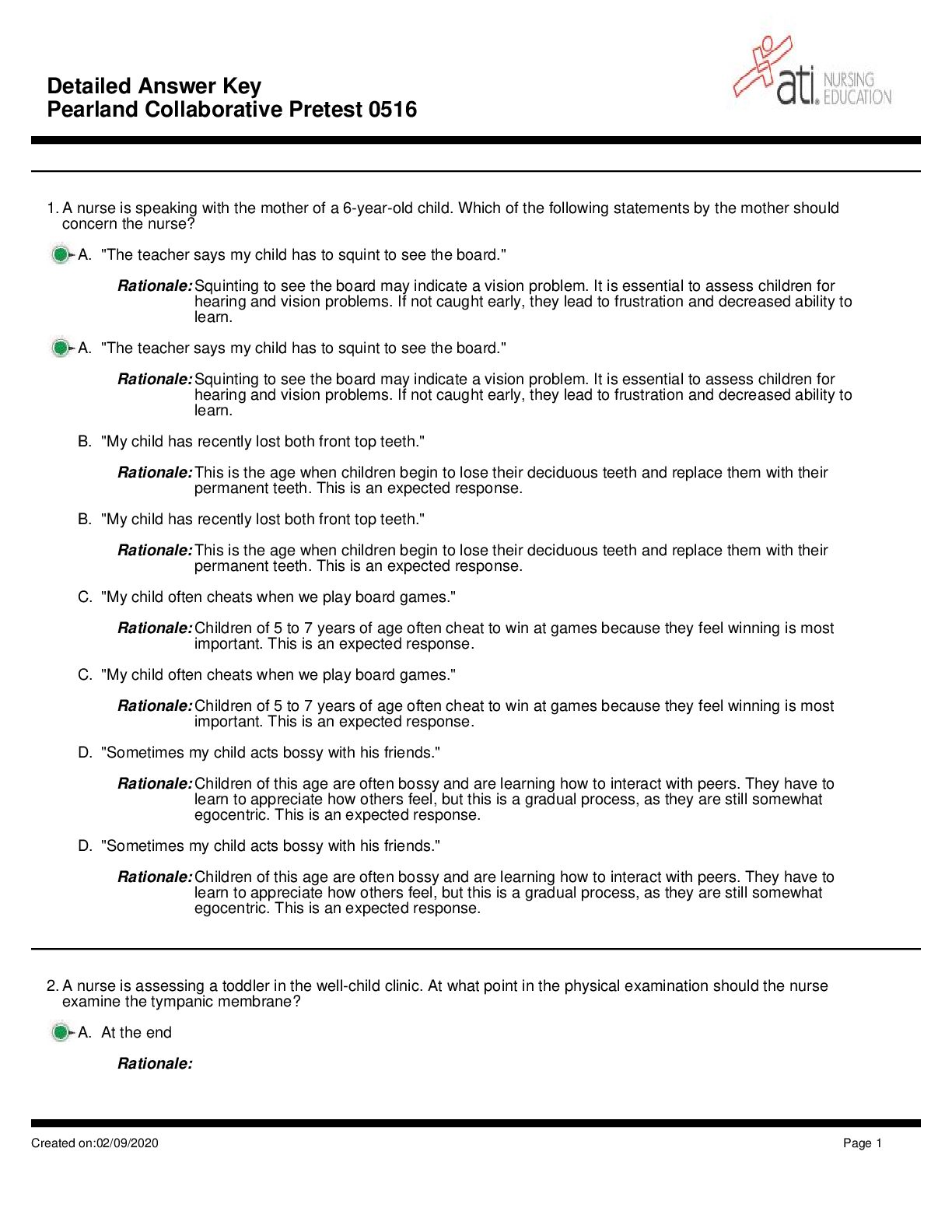
Buy this document to get the full access instantly
Instant Download Access after purchase
Buy NowInstant download
We Accept:

Reviews( 0 )
$23.50
Can't find what you want? Try our AI powered Search
Document information
Connected school, study & course
About the document
Uploaded On
Feb 09, 2021
Number of pages
82
Written in
Additional information
This document has been written for:
Uploaded
Feb 09, 2021
Downloads
0
Views
106

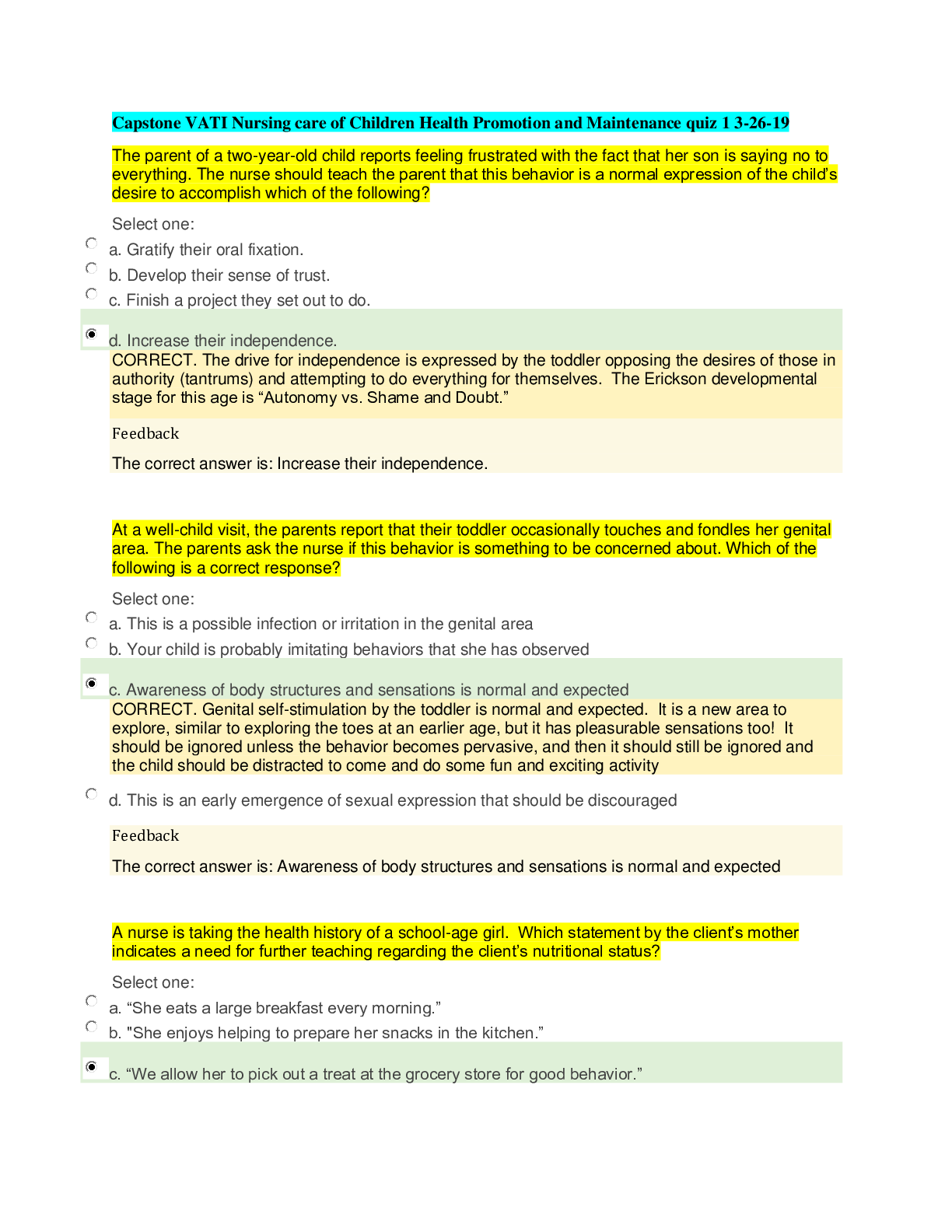
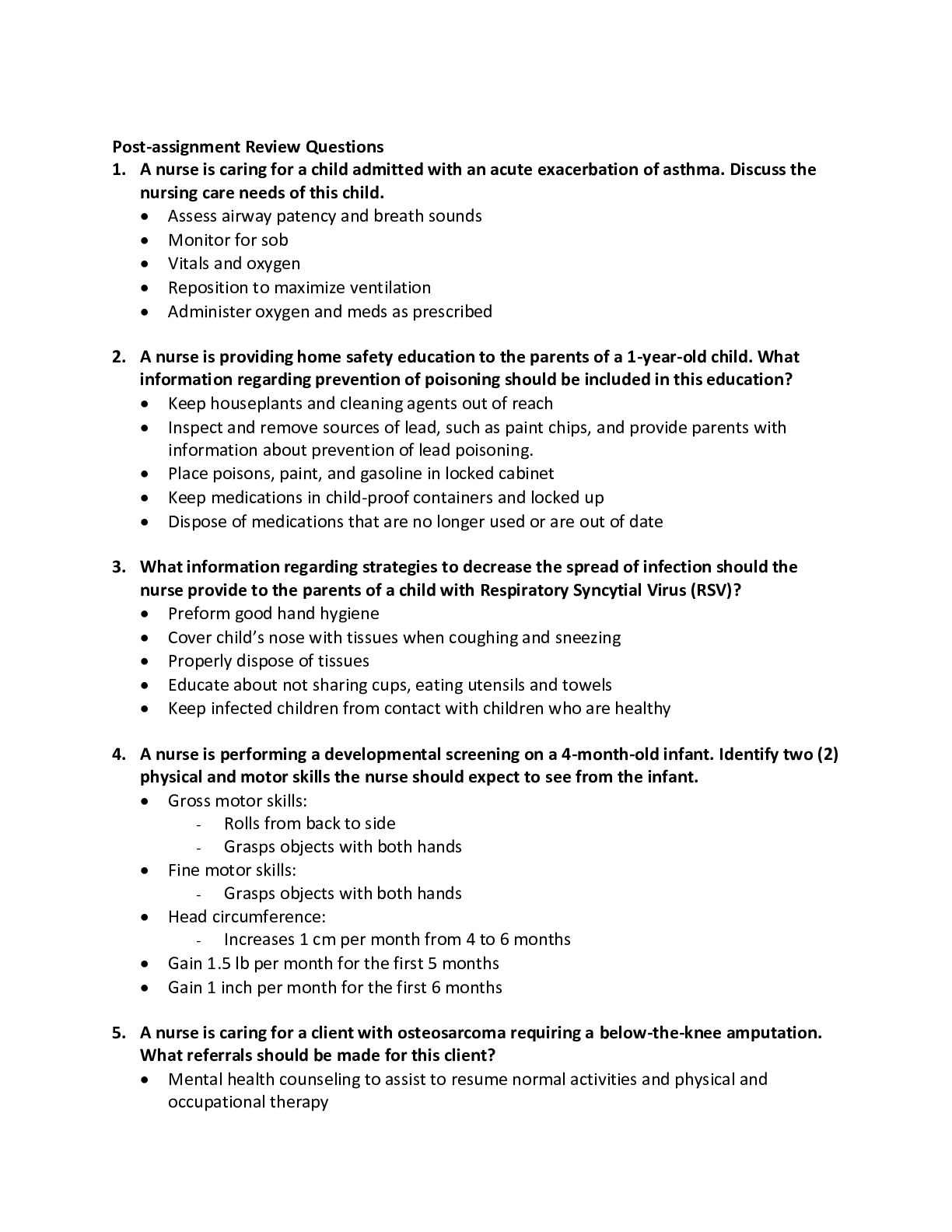
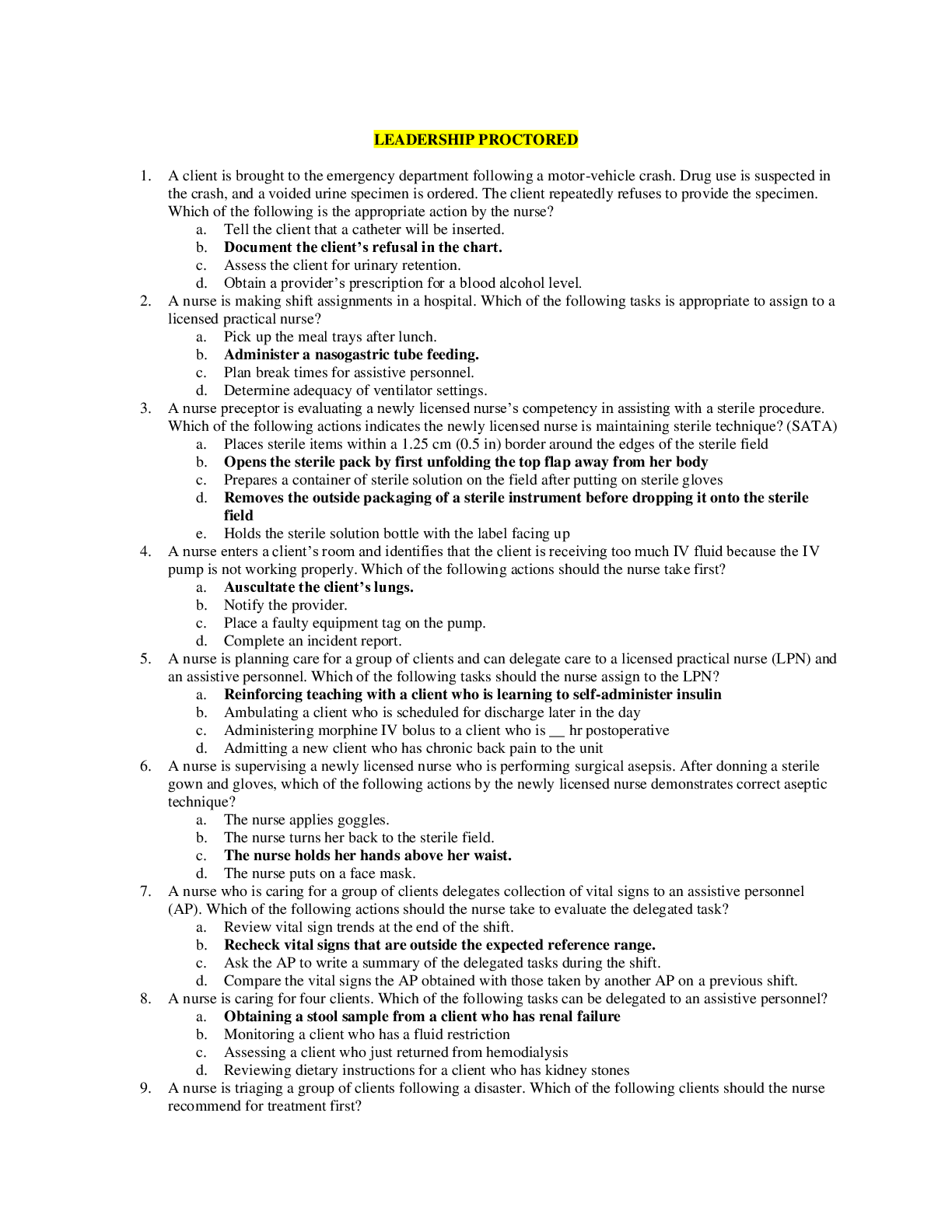


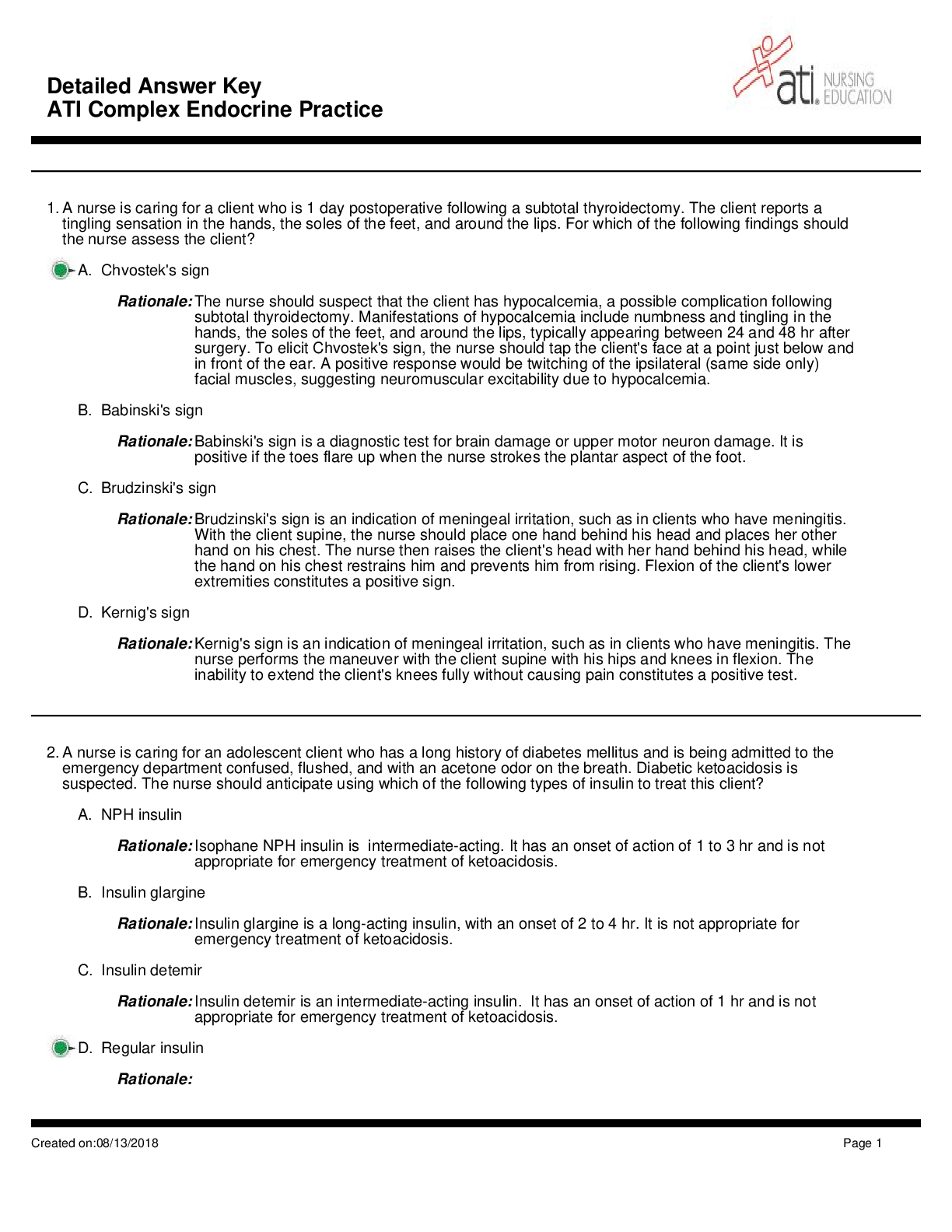
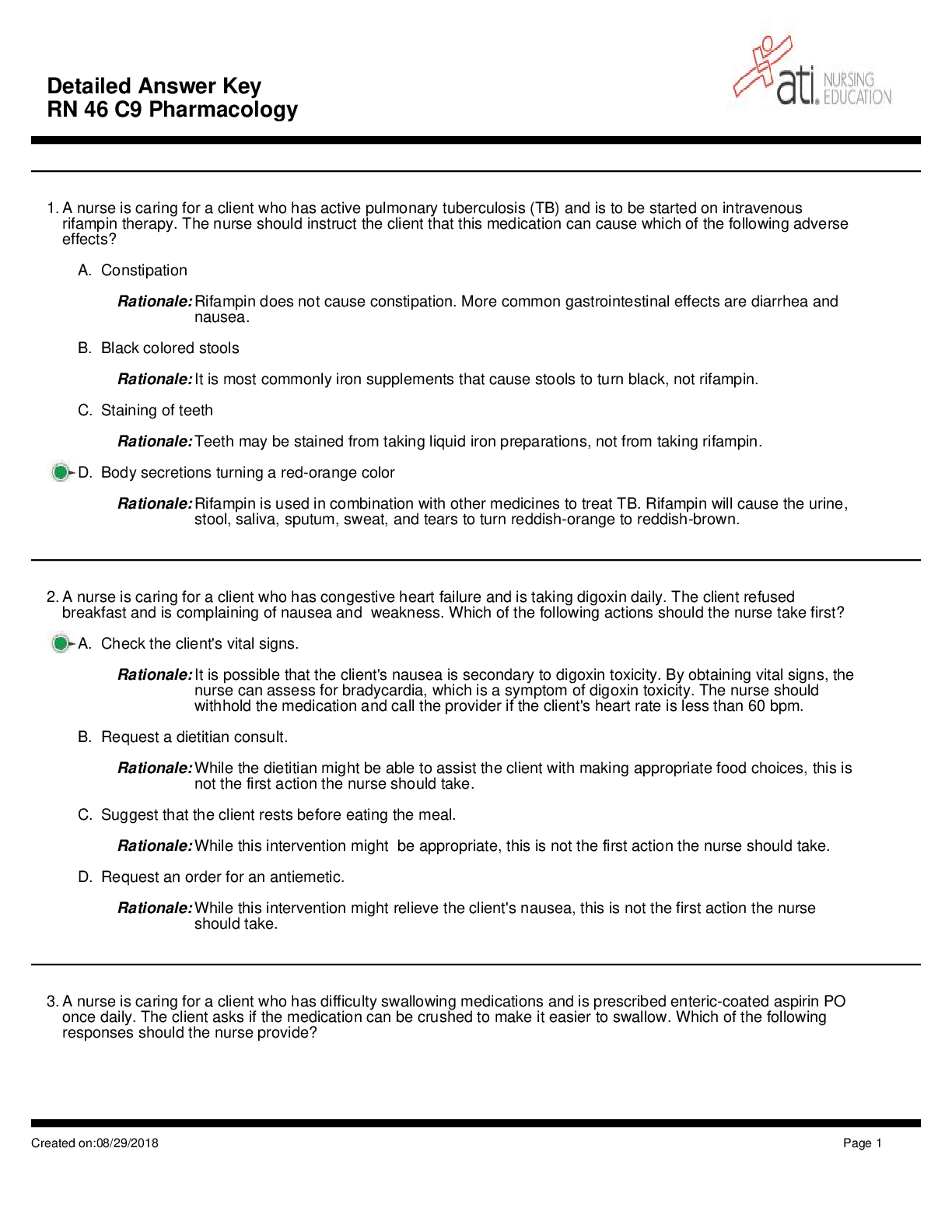


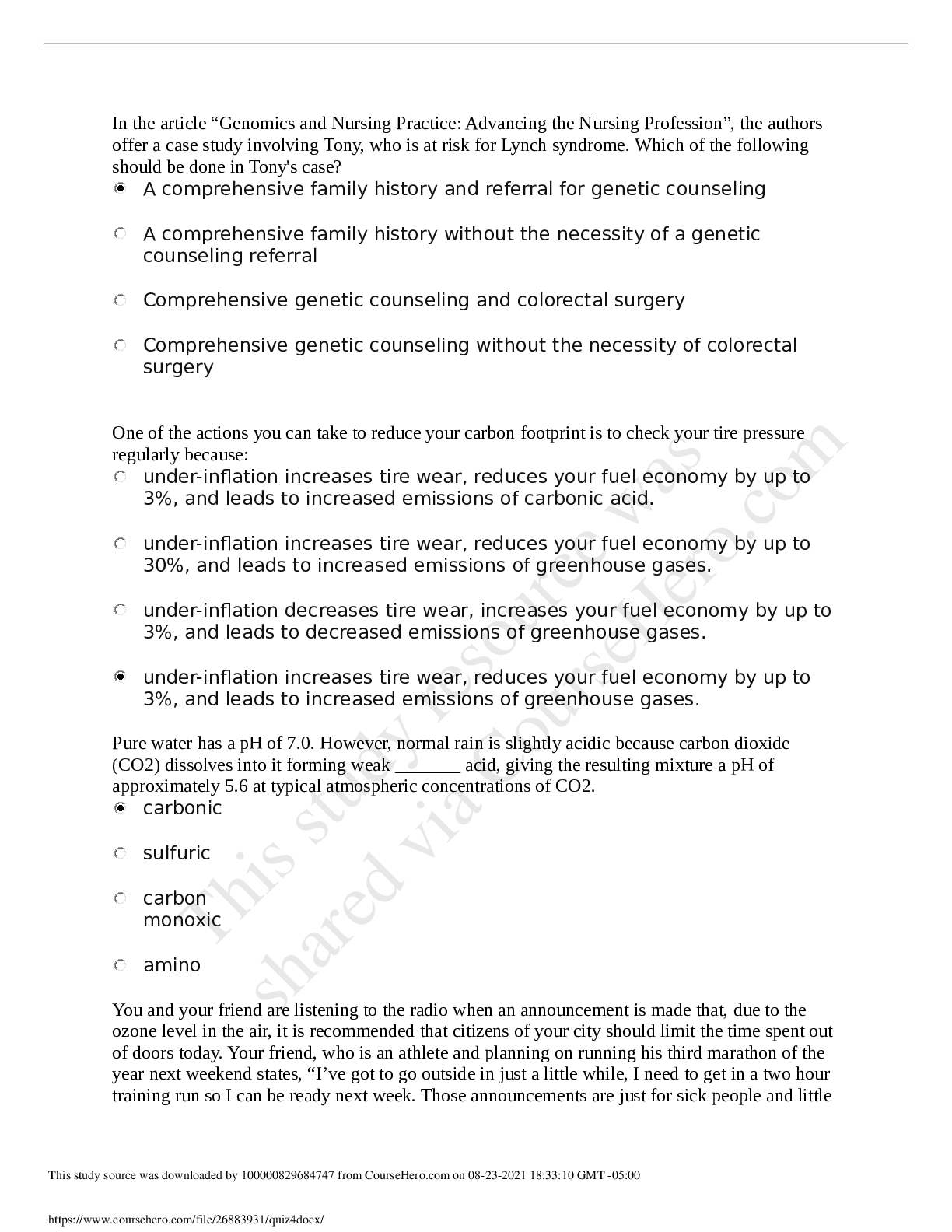
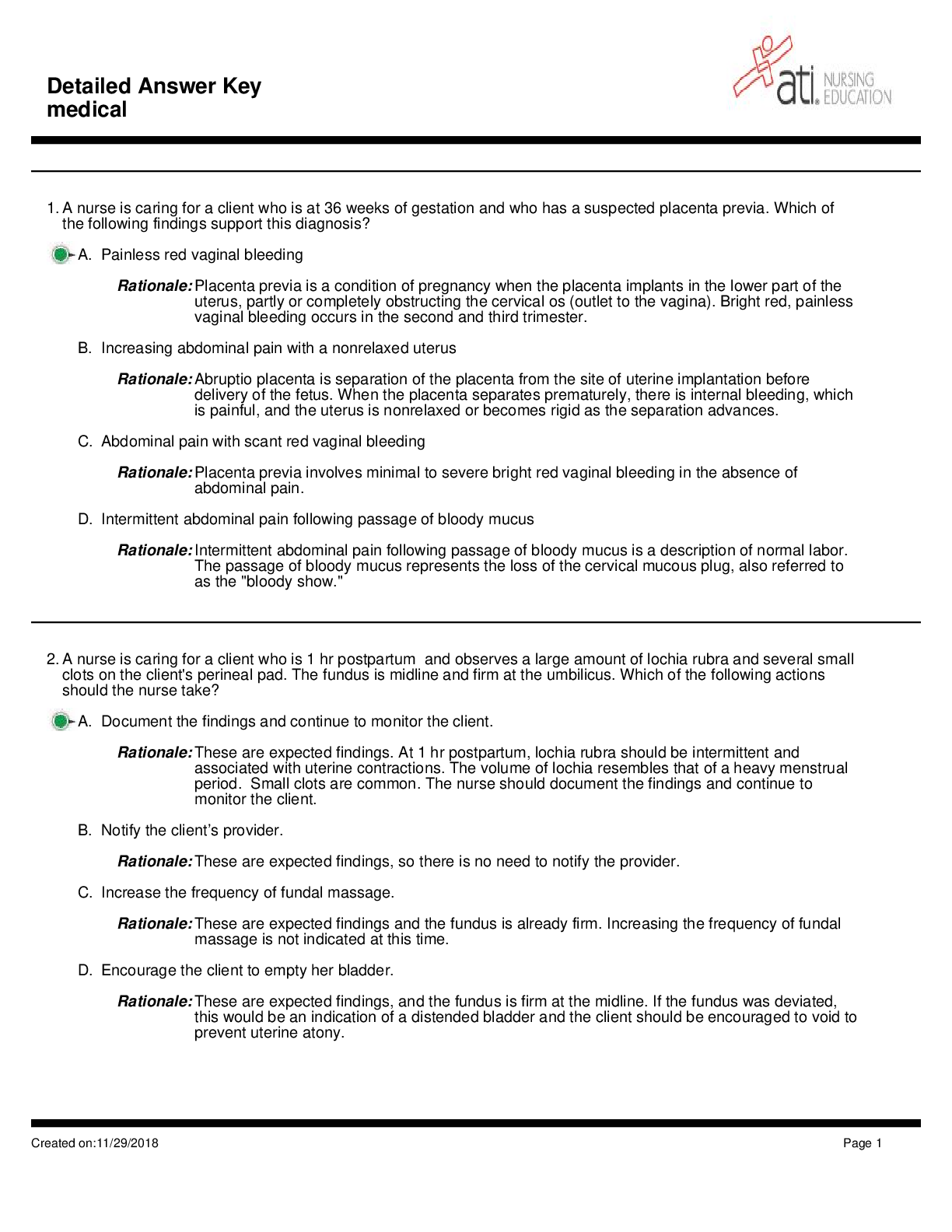
.png)

 Graded A.png)

